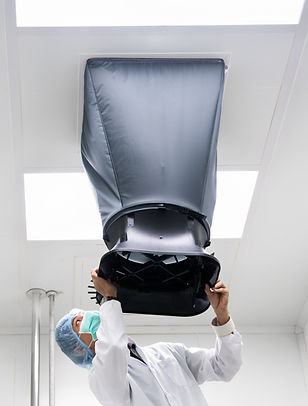
What are the safe levels of mold in the air?
There isn't a universally agreed-upon "safe" level of mold in the air, as it can vary depending on individual sensitivity, the type of mold, and environmental factors. However, some guidelines and general practices can help assess air quality concerning mold:
It is undesirable to have mold in the indoor environment
1. No Visible Mold?
-
Ideally, there should be no visible mold growth indoors. If mold is visible, it should be removed regardless of the concentration of mold spores in the air.
2. What about Spore Types and Total Counts?
-
Indoor vs. Outdoor Levels: A common method to assess mold levels is to compare indoor air samples to outdoor air samples. If indoor mold spore counts are significantly higher than outdoor levels, it may indicate an indoor mold problem.
-
General Guidelines: In general, indoor air should have lower or similar levels of mold spores compared to the outdoor environment. High indoor levels relative to outdoor air might suggest a mold problem.
3. Are There Quantitative Guidelines?
-
While there's no strict "safe" threshold, some environmental consultants may use rough guidelines for total spore counts:
-
Below 200-500 spores/m³: Often considered normal for indoor air.
-
500-1,500 spores/m³: Some potential for concern, especially if sensitive individuals are present.
-
Above 1,500 spores/m³: Potentially problematic, indicating a need for further investigation and possible remediation.
-
These are rough estimates and not regulatory standards.
-
4. What About The Type of Mold?
-
The type of mold present is also crucial. Some molds, like Stachybotrys (often called "black mold"), can produce mycotoxins and are considered more dangerous at lower concentrations.
5. What Are The Health Effects?
-
Individual sensitivity varies. People with allergies, asthma, compromised immune systems, or other health conditions may experience symptoms even at low mold spore levels. In such cases, even small amounts of mold may not be considered "safe."
6. Are There Established Regulatory Standards?
-
Currently, there are no established federal guidelines or standards for acceptable mold spore levels in the air, although some local or industry-specific guidelines might exist.
7. What about an Action Threshold?
-
The action threshold often depends on health symptoms, building history, and professional judgment rather than a specific spore count.
Conclusion:
If mold is suspected, testing and professional consultation are recommended, particularly for people with respiratory issues or allergies. Remediation should focus on removing the source of mold, controlling moisture, and ensuring proper ventilation.
Common FAQ’s about air quality testing for mold

How does an air quality test detect mold?
Yes, an air quality test can detect mold. Specifically, air quality tests for mold are designed to measure the concentration of mold spores in the air. Since mold spores and fungal fragments are microscopic, the only way to determine their concentration in the air is by conducting air sampling tests.
Here's how it works:
-
Air Sampling: During the test, a professional collects air samples from different areas of your home or building. This is done using specialized equipment that traps airborne particles, including mold spores, onto a medium.
-
Laboratory Analysis: The collected samples are then sent to a laboratory, where they are analyzed under a microscope. The lab identifies the types of mold spores present and quantifies their concentration in the air.
-
Interpreting Results: The results will show the presence and levels of mold spores, which can help determine if there is a mold problem. High concentrations of certain mold types may indicate an active mold growth issue that requires remediation.
However, it's important to note that while air quality tests can detect airborne mold spores, they may not always identify mold that is growing on surfaces or hidden in areas where air sampling is not conducted. In some cases, additional testing, such as surface sampling or moisture assessments, may be necessary to fully assess mold issues.




